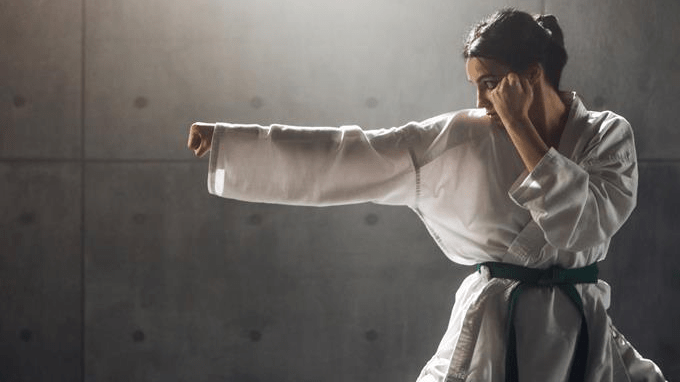by: Maddie Poppish
Hi guys! Maddie here! Today I am going to talk to you about karate, which I have been doing for over 2 years now. I will go over the history of karate and how my karate system works.
Although karate evolved in East Asia over a period of centuries, it only became systematized 200 years ago, in the 17th century. It started in Okinawa, when a ban on weapons was placed. People had to figure out a way to fight with their hands, and that is when karate developed. Karate actually means “empty handed” in Japanese. It was introduced to Japan in 1920, and soon karate schools popped up around the world.
Now that the basic history of karate is covered, I will review what my system teaches and how that differs from other karate systems/schools. In my system, you start out as a white belt. As you progress on through this belt, you earn stripes. A stripe symbolizes growth in the knowledge of karate and the understanding of certain kicks, strikes, and defense moves you will need to advance to the next color belt. The greatest amount of stripes you can earn is three stripes. The number of stripes you have is said like this; (number of stripes) review (color belt). For example, if a karate student is a second review blue belt, they are a blue belt with two stripes. If you have no stripes, you are a solid belt, not a review.
After you have proven yourself, you get a new belt with a different color and a new go that matches the belt color. My system has belts in this order; white belt, blue belt, brown belt, red belt, and black belt. The red belt is new in our system. Before that, you would go directly from brown belt to black belt. Now, the system has split the knowledge that you learned at brown belt into two groups. The first group is the new curriculum learned at brown belt, and the second group is the new curriculum now learned at red belt.
Here is the cool stuff you learn at each belt!
White belt: Since this is the first building block, you only learn basic kicks, strikes, and blocks. When you are at solid or first review white belt, you learn how to block a strike and hit back with another strike. When you are at second or third review, you learn how to block and strike back with two strikes, not just one.
Blue belt: This belt is really fun! You are introduced to sparring, which means blocking and striking with an opponent. Basically, it means fighting an opponent by punching and blocking. You wear headgear, arm pads, and a mouth guard when sparring someone for protection. Tactics are also introduced at this level, which is a group of moves used to take someone down. The group of tactics you learn at blue belt are called tiger tactics. I will get into the other groups of tactics later on. There are twelve tiger tactics. You learn 1-4 at solid blue belt, 5-8 at first review, and 9-12 at second review. These tactics are known as “righties” because your opponent is striking at you with their right hand. Besides this cool stuff, you start to use kicking and punching pads with an opponent. This is when an opponent holds up a pad for you to punch or kick.
Brown belt: A lot of stuff is introduced at brown belt! First off, you learn “leftie” tactics, which you would use if your opponent was attacking with their left hand. Exactly like in blue belt, you learn lefties 1-4 at solid brown, 5-8 at first review brown, and 9-12 at second review brown. Another thing that you learn at brown belt is bo staff sparring! This is when you spar with a long foam stick, known as a bo staff. You learn how to strike an opponent with a bo staff and how to block when your opponent tries to strike you. You also learn open-handed strikes, which is when you use an open hand instead of a fist. Lastly, you start using kicks in sparring, learn new kicks like hook kicks, bow kicks, and roundhouse kicks, and start using light touch contact in sparring. In blue belt, you do not use touch contact or kicks in sparring. You get leg guards for kicking in sparring and special shoes that make it easier to pivot when kicking in brown.
Because the red belt is relatively new, I do not know the curriculum. As for black belt, I do not know much, besides the fact that there are multiple degrees of black belt. For example, you start off as a first degree, then get three yellow stripes, and then excel to a second degree black belt. There are 10 degrees of black belt. One thing I do know about black is that you learn new forms of tactics! There are leopard tactics, crane tactics, snake tactics, and dragon tactics. Masters learn monkey tactics, which are the craziest and most challenging of the tactic groups.
Different systems may have different color belts. For example, one system may have green and yellow belts, while another may have neither of these, but does have red and blue belts. The curriculum and moves learned in one karate system may or may not be taught in another different system.
And that’s karate! Hope this blog was fun to read!
